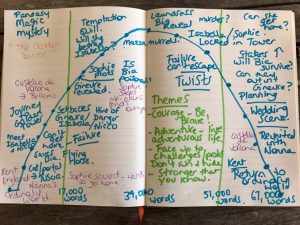Hi Westworders,
When I was younger, I never ever planned my stories. I always sat down with a pen and paper and just wrote. It was exciting to see where my story would take me. Sometimes I got very muddled. Sometimes I got completely lost. And very often my story would get stuck right in the middle. I’d get writers’ block and couldn’t finish what I’d begun. Often that story would end up scrunched into a ball and thrown in my bin.
But once I became a published author, I discovered a secret. A secret that made it so much easier for me to write and to meet my tight deadlines. (Publishers, like your teachers, are really tough and make authors write books in a very short time!!)
The secret I discovered was that most authors who write lots of books always, always plan their stories out first. Famous authors like J.K. Rowling, John Flanagan, Jacqueline Harvey, Tim Harris, Deborah Abela and RA Spratt. They often do it in different ways to each other and sometimes different ways for different books.
For example, RA Spratt wrote a post a few weeks ago about how she uses Joseph Campbell’s circle – The Hero’s Journey to map out all her books. Jacqueline Harvey wrote about how she brainstorms and jots in her notebook and on her whiteboard. Tim Harris also wrote a post about his plotting and planning process.
Why plan? A plan is like a recipe when you are cooking or a map when you are travelling.
- Shines a light ahead
- A map to show you where you are heading
- The plan will change and evolve over time as you get better ideas
- Saves time when you are writing
- The synopsis keeps you focused
- Stops you wasting words or going off on dead ends and tangents
- Helps structure story strongly
I use often a plan which I call The Rollercoaster Plan, because it reminds me that my story needs to get more and more exciting, plus it helps me keep track of my word count and the timeline of my story.
Draw a story arc. This is an upside down U that shows the progress of your story like a rollercoaster ride. The beginning is the everyday world of your characters. At the start of the story you need to spend some time getting to know your characters so the reader understands their world and cares about what happens to your characters. The next part of the story is the Rising Action. The story gets more exciting as more problems and trouble occur for the characters. The crisis or climax is the most exciting part of the story. After the climax is the Falling Action, as the problems are solved, the world returns to normal, and the story ends.
It looks a little like this:

- The ordinary world – introducing my characters, setting, theme, and problem, building empathy with my reader. What does my hero want?
- Extraordinary world. Inciting incident – something changes to start the adventure. Rising Action with problems, conflict and obstacles, building the tension and excitement. My character tries and fails. Tries and Fails.
- Midpoint reversal. The crisis. The darkest, most frightening part of the story where winning seems impossible. It looks like the antagonist must prevail.
- The Climax. This is where my hero “seizes the sword” and solves the problem.
- The ending should be satisfying eg funny, surprising, delightful, a twist? How has my hero changed on their journey? What have they learned?
This is what the Rollercoaster Plan for the Golden Tower looks like in my notebook!

Do you plan your stories? Or do you fly by the seat of your pants, writing as you go? Or a mixture of both?
Share your ideas in the comments below. I’d love to hear about them.
Happy plotting!
Belinda Murrell

0 Comments